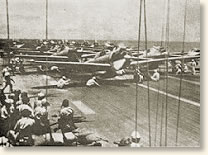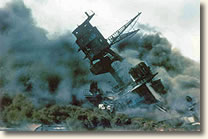|
Attack At Pearl Harbor, 1941
The Japanese attack fleet left its home waters on November 26 steaming a circuitous route towards Pearl Harbor. Fleet Commander, Vice Admiral Nagumo, received his final orders on December 1 and on the morning of December 7 the battle group was in position 275 miles north of Hawaii. At 6:00 AM the first elements of the air attack consisting of fighter aircraft, torpedeo bombers, high-level bombers and dive-bombers were aloft and assembling in the pre-dawn gloom.
Commander Mitsuo Fuchida led the first wave of the air attack and published his recollections in 1951. These were later published in English in 1955. We join his story as he approaches the Hawaiian coast:
 |
Japanese attackers prepare
for take off |
"One hour and forty minutes after leaving the carriers I knew that we should be nearing our goal. Small openings in the thick cloud cover afforded occasional glimpses of the ocean, as I strained my eyes for the first sight of land. Suddenly a long white line of breaking surf appeared directly beneath my plane. It was the northern shore of Oahu.
Veering right toward the west coast of the island, we could see that the sky over Pearl Harbor was clear. Presently the harbor itself became visible across the central Oahu plain, a film of morning mist hovering over it. I peered intently through my binoculars at the ships riding peacefully at anchor. One by one I counted them. Yes, the battleships were there all right, eight of them! But our last lingering hope of finding any carriers present was now gone. Not one was to be seen.
It was 0749 when I ordered my radioman to send the command, 'Attack!' He immediately began tapping out the pre-arranged code signal: 'TO, TO, TO...'
Leading the whole group, Lieutenant Commander Murata's torpedo bombers headed downward to launch their torpedoes, while Lieutenant Commander Itayay's fighters raced forward to sweep enemy fighters from the air. Takahashi's dive-bomber group had climbed for altitude and was out of sight. My bombers, meanwhile, made a circuit toward Barbers Point to keep pace with the attack schedule. No enemy fighters were in the air, nor were there any gun flashes from the ground.
The effectiveness of our attack was now certain, and a message, 'Surprise attack successful!' was accordingly sent to Akagi [Flagship of the Japanese attack fleet] at 0753. The message was received by the carrier and duly relayed to the homeland, ...
The attack was opened with the first bomb falling on Wheeler Field, followed shortly by dive-bombing attacks upon Hickam Field and the bases at Ford Island. Fearful that smoke from these attacks might obscure his targets, Lieutenant Commander Murata cut short his group's approach toward the battleships anchored east of Ford Island and released torpedoes. A series of white waterspouts soon rose in the harbor.
Lieutenant Commander Itaya's fighters, meanwhile, had full command of the air over Pearl Harbor. About four enemy fighters which took off were promptly shot down. By 0800 there were no enemy planes in the air, and our fighters began strafing the airfields.
My level-bombing group had entered on its bombing run toward the battleships moored to the cast of Ford Island. On reaching an altitude of 3,000 meters, I had the sighting bomber take position in front of my plane.
As we closed in, enemy antiaircraft fire began to concentrate on us. Dark gray puffs burst all around. Most of them came from ships' batteries, but land batteries were also active. Suddenly my plane bounced as if struck by a club. When I looked back to see what had happened, the radioman said: 'The fuselage is holed and the rudder wire damaged.' We were fortunate that the plane was still under control, for it was imperative to fly a steady course as we approached the target. Now it was nearly time for 'Ready to release,' and I concentrated my attention on the lead plane to note the instant his bomb was dropped. Suddenly a cloud came between the bombsight and the target, and just as I was thinking that we had already overshot, the lead plane banked slightly and turned right toward Honolulu. We had missed the release point because of the cloud and would have to try again.
While my group circled for another attempt, others made their runs, some trying as many as three before succeeding. We were about to begin our second bombing run when there was a colossal explosion in battleship row. A huge column of dark red smoke rose to 1000 meters. It must have been the explosion of a ship's powder magazine. [This was the Battleship Arizona] The shock wave was felt even in my plane, several miles away from the harbor.
We began our run and met with fierce antiaircraft concentrations. This time the
lead bomber was successful, and the other planes of the group followed suit
promptly upon seeing the leader's bombs fall. I immediately lay flat on the
cockpit floor and slid open a peephole cover in order to
 |
| The USS Arizona in flames |
observe the fall of the bombs. I watched four bombs plummet toward the earth. The target - two battleships moored side by side - lay ahead. The bombs became smaller and smaller and finally disappeared. I held my breath until two tiny puffs of smoke flashed suddenly on the ship to the left, and I shouted, 'Two hits!'
When an armor-piercing bomb with a time fuse hits the target, the result is almost unnoticeable from a great altitude. On the other hand, those which miss are quite obvious because they leave concentric waves to ripple out from the point of contact, and I saw two of these below. I presumed that it was battleship Maryland we had hit.'
As the bombers completed their runs they headed north to return to the carriers. Pearl Harbor and the air bases had been pretty well wrecked by the fierce strafings and bombings. The imposing naval array of an hour before was gone. Antiaircraft fire had become greatly intensified, but in my continued observations I saw no enemy fighter planes. Our command of the air was unchallenged."
As the first wave of the attack made its way back to its carriers, Commander Fuchida remained over the target in order to assess damage and to observe the second wave attack. He returned to his carrier after the second wave successfully completed its mission.
References:
Fuchida, Mitsuo and Masatake Okumiya, Midway, the Battle that Doomed Japan (1955); Lord, Walter, Day of Infamy (1957).
How To Cite This Article:
"Attack At Pearl Harbor, 1941, - the Japanese View" EyeWitness to History, www.eyewitnesstohistory.com (2001).
|






